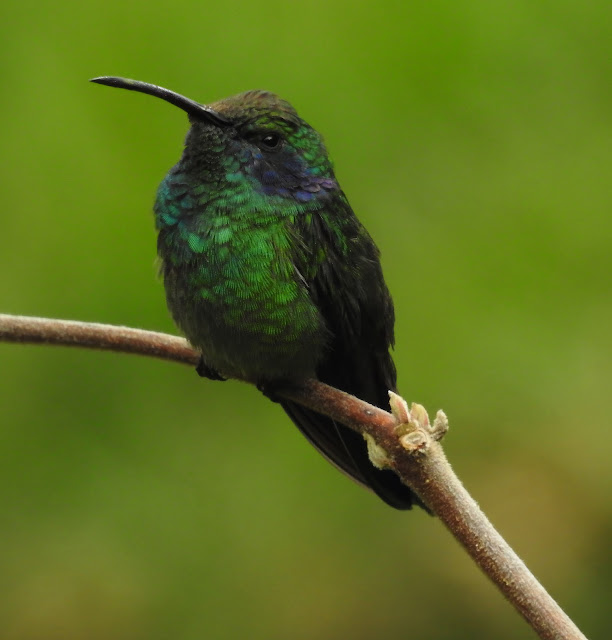The Purple-throated Mountaingem, scientifically known as Lampornis calolaemus, is a diminutive and vibrant species of hummingbird. Measuring between 10 to 11.5 cm in length and weighing a mere 4.5 to 6 grams, these birds are adorned with a medium-length straight black bill, a distinctive white to pale buff stripe behind the eye, and a fairly long tail that adds to their elegant appearance.
Adult males of the nominate subspecies boast a glittering emerald green to bluish green forehead and crown, with metallic bronze-green upperparts that transition to bluish or grass green on the uppertail coverts. Their faces are dusky bronze green, and they feature a striking metallic violet or purple gorget. The breast shines with bright metallic green, while the flanks and belly are a more subdued bronzy green or gray. The undertail coverts are deep bronzy gray with paler gray margins, and the tail is a dull blue-black.
Adult females present bright metallic green upperparts with a bluish tinge on the uppertail coverts and a more bronzish hue elsewhere. Their faces are predominantly blackish, and the throat, breast, and belly are tawny yellow, transitioning to dull white to tawny buff on the undertail coverts. The central tail feathers and the upper half of the others are dull metallic green or bronze green, with the lower half of the outer tail feathers mostly black with pale gray tips.
The Purple-throated Mountaingem inhabits humid montane evergreen forests and cloudforests, preferring steep slopes and broken terrain. In central Costa Rica, they range from elevations of 1,200 to 2,500 meters, and can be found as low as 800 meters in the northern regions.
This species is found in Costa Rica, Nicaragua, and Panama, with three subspecies distributed across different regions. L. c. pectoralis resides from southwestern Nicaragua to northwestern Costa Rica, L. c. calolaemus in northern and central Costa Rica, and L. c. homogenes in western Panama and possibly southern Costa Rica.
Post-breeding season, some Purple-throated Mountaingems descend to elevations as low as 300 meters. Males are known to fiercely defend their feeding territories, which include patches of flowers, from both conspecifics and other hummingbird species.
The song of the Purple-throated Mountaingem is a high, thin, and dry medley of sputtering and warbling notes. Their calls are sharp and penetrating, often described as "trrrt" or a buzzy "zeet" or "zeep," with higher-pitched, scratchy, chattering notes during interactions.
Breeding occurs from October to April, coinciding with the rainy season. Females single-handedly undertake nest building, incubation, and care for the nestlings. The nest is a thick-walled open cup adorned with moss and lichen, typically situated about 2 meters above ground. Incubation lasts 17 to 18 days, with fledging occurring 22 to 23 days post-hatch.
The Purple-throated Mountaingem primarily feeds on nectar, with males defending their feeding territories vigorously. Females, less territorial, often feed by trap-lining. They are the primary pollinators of certain Rubiaceae species. Insects also form part of their diet, with males capturing them by hawking from a perch and females employing hover-gleaning tactics.
The IUCN has classified the Purple-throated Mountaingem as Least Concern. The population, estimated between 50,000 and 500,000 mature individuals, is believed to be decreasing. However, despite some habitat alteration by humans, much of their habitat remains intact, and the species has shown strong resilience to these changes.




%2010.jpg)
%2011.jpg)
%2010.jpg)
%2012.jpg)
%2014.jpg)
%2020.jpg)
%2021.jpg)
%2020.jpg)

%20(Sympetrum%20fonscolombii)%2020.jpg)
%20(Sympetrum%20fonscolombii)%2021.jpg)




%2020.jpg)
%2021.jpg)
%2020.jpg)
%2020.jpg)
%2021.jpg)
%2022.jpg)





%2020.jpg)
%2022.jpg)
%2021.jpg)
%20(Chroicocephalus%20ridibundus)%2020.jpg)
%20(Chroicocephalus%20ridibundus)%2021.jpg)
%2020.jpg)
%2021.jpg)
%2022.jpg)




%2020.jpg)